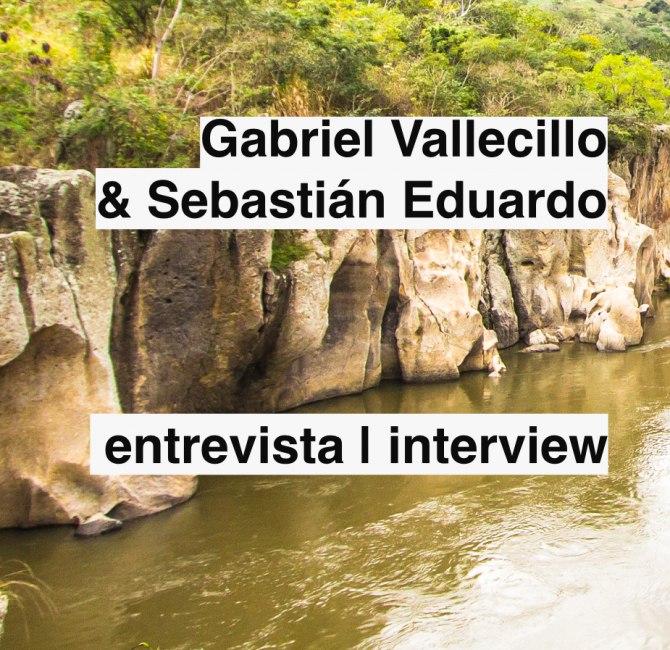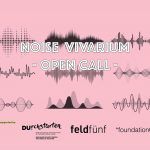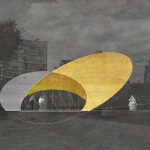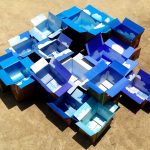
¡n[s]urgênçias 2018 as subjective and corporeal experience / An essay by Sebastián Eduardo
About the author:
Sebastián Eduardo [Dávila] (* Guatemala, 1993) was born in Guatemala City and studied History of Art and Film Sciences at the Friedrich Schiller University in Jena (BA), at the National Autonomous University of Mexico in Mexico City and at the Freie Universität in Berlin (MA). He will begin a doctoral project at the Leuphana Universität in Lüneburg on decoloniality in contemporary art in Guatemala. In 2016, he took part in a lecture at the 91. Kunsthistorischen Studienkongress in Leipzig and has published articles in the Lateinamerika Nachrichten magazine and in exhibition catalogs in Jena and Weimar. In 2015, he curated the Kunst und Krise exhibition in Jena and has worked as a student teacher and assistant at the universities of Jena and Berlin and as a practitioner in the collection of the University Museum of Contemporary Art in Mexico City. He is currently working as a mediator at the Galerie Wedding and at KINDL – Zentrum für Zeitgenössische Kunst in Berlin. Since 2018, he has volunteered in the organization of events and in the writing of articles for the Peace Brigades International website.
I. About ¡n[s]urgênçias : call for Latin American artists in Berlin

Artists and collaborators responded, in one way or another, to a call composed of three words that state the practice and geographies of those to whom it is addressed: ‘Latin American artists in Berlin’. Responding to such call is an act of identification, as a professional and as a subject / body, with the identity categories that it proposes. Geographically, this identity is constructed not only from a fixed place – of origin -, but from the mobility between origin and a second place – of residence -. Thus, moving from a country or countries in a huge region to a single European city, German, is one of the main cores of the encounter between subjects / bodies on which the call is based: cultural migration. Responding to ¡n[s]urgênçias, the title of a series of encounters between artists and collaborators organized by Paz Ponce, also implies an identification with this term, greatly altered, but also with the alteration of it. The insurgency is proposed as a fusion of emerging artists with the urgency of both their cultural activities and the contexts to which they react. As a verb, participation in the meetings invites us to insurge in geographies of origin, residence and others, as well as in institutions and formats of what we call contemporary art. The alteration of the title holder indicates, first, that it is not one but insurgencies in plural, each linked to subjective / bodily experiences. Second, it allows reading in Portuguese, in Spanish and in ‘portuñol’ – which was often the means of communication between artists and collaborators -, reminding us of the multilingual and hybrid nature, apart from plural, of the Latin American region. Finally, the typographical alteration of the title invites us to do that: to alter, both inside and outside the program. It was to this call that I, as a cultural and academic migrant and as a ‘ladino’ Guatemalan, responded.
II. About artists and works in sync
I would like to touch on down the complexity that I associate with the call and the program in the practice of some of the artists gathered, especially in what they presented on September 29 at an event open to the public in Agora Collective. The plurality of practices and subjective / bodily experiences allow to unravel the category of ‘Latin American art’ that, according to the criticism of Gerardo Mosquera, describes a series of characteristics that make up the essence of what that category enunciates (Mosquera 2010). In the case of ¡n[s]urgênçias it is necessary, beyond Mosquera’s definition, to reflect on cultural migration to Berlin as an identity and creative element. The plurality of tasks and sentiments does not mean that, apart from identifying themselves as ‘insurgent Latin American artists’, the participants have nothing in common, on the contrary: during the meetings and in the public program, links were formed based on collective strategies and concerns. The program allowed linking through collaborations between artists and dialogues between collaborators, artists and work. I would like to investigate such ties, understanding them as synchronies – temporal – of geographies, subjectivities and bodies. I intend to reconstruct them from my subjectivity / corporeality, moving organically through proposals and without giving a general overview of what is presented. This is not an exhibition catalog text.
The term “synchrony” I take from Moana Mayall, who in her work in process Cartography investigates, from her subjectivity and migrant corporeality, relations between the group of Favelas Complexo do Alemão in Rio de Janeiro and Berlin, whose Germanity she also suggests as a complex – historical and social -.
In the favela, the artist becomes a ‘German’ as a synonym of not belonging, while in Berlin she is understood as representative of Brazil, if not Latin America in general, which she shares with the other artists. Her work is especially linked to Jefferson Andrade, who also operates from the favela, opening spaces for political and artistic dialogue; a practice that takes up in Berlin from collective publications and artistic and mediation processes.

Moana presented, among others, the video Charlieand the White Elephant, where she relates national political discourses that materialize in more or less functional and tourist monuments. In it, the narrator flies for the first time over the Complexo do Alemão on a cable car or ‘white elephant’, installed as a gesture of progress and safety. Her gaze from the sky watches and controls. In Berlin, the narrator addresses one of the tourist guards of Checkpoint Charlie, posing in front of flags and the historic booth passing between East and West of the city, asking who he works for. While he responds that “he works for himself”, the flag of the United States is suddenly crossed in front of his face, introducing an unexpected element, extremely symbolic, that complements the reply. Through the work, different narrative levels – for example what the guard says and what happens while saying it – are revealed as synchrony through the investigative experience of the migrant artist. Moana does not close the possibility of generating new links with her research, opening it up to endless possibilities.
Both the flag in its function of signifier of a Nation-State, as well as the migratory experience itself are creative elements that reappear in the work that Manuela García Aldana presented in Agora. First, she asked collaborators and artists to give her personal objects that would remind us of the place from which we migrated and that would materialize, thus, the memory of migrating from the collection and care of objects. On a table, the artist placed the fetishes forming a sort of altar to our migrations and migration in general. Sacredness, derived from Christian practices and altered through syncretism – an insurgent process in itself – is repeated in the Migrant Confessional, in which Manuela, together with the collective Las Milagreras, invited migrants to share / confess experiences in a dark and long pipe tunnel. Intimate and at the same time intimidating, this space radically contradicts white cube and resists its institutionalization.
In the same hallway and before entering the confessional, Alberto Morreo installed a series of empty and broken glass cases on pedestals, fracturing a central exhibition element of the white cube: the showcase. The third work of Manuela, Sutura (Berlin, 2018), consisted of a flag, stitched together with the collective of the same name, yellow, blue and red stripes, the red being much larger than the others. The Colombian national colors, which by the way are repeated in several countries of South America, are national references altered by the artist in a monumental and fragile work that intervenes in the space with violence. That violence and the fragility of the seams point to the urgency of the context to which it refers: The seizure of Iván Duque as president of Colombia, which in tune with former President Álvaro Uribe intervenes in the peace agreements.


It is to that context that Alexandra Bisbicus refers inside and outside her textile work. Both the environmental and social violence derived from megaprojects in rural and often indigenous areas, as well as forms of resistance from women inspire Alexandra’s practice, which works with the textile as a medium anchored in indigenous and feminine / feminist traditions and as a metaphor for the social fabric in those contexts: fragile, but also intertwined and thus strong, always in process. In Agora, the artist wove on images of border fences printed on a textile that hung from the ceiling. With dark red she completed and expanded the image, linking the border with cracks in columns and on the roof of Agora. Like Alberto and Manuela, Alexandra questioned the space in which she exhibited with her work.

Manuela Eichner also referred to the space in which she exhibited, fragmenting and physically rebuilding it in a three-dimensional collage that is her favorite technique. With plants, construction plates and other objects that she found, her work included a screen that presented the documentation of her Monstra choreography, made last year with Elisabete Finger. In it, a group of women interact with and against domesticated plants, referring at times to classic poses of art history and altering them through the act of urinating. Performers burst with their pee in the assigned roles that are intended to “tame” them, like plants, from the realm of the institutional and the social. The plant in its pot becomes, for Manuela, a metaphor for the domestication of nature and femininity and its possible rupture. In Germany, plants that are both common and apparently exotic,- in Ikea, a ‘Monstera Deliciosa’ costs € 4.99 – come to denote fantasies about Brazil and Latin America.

Andressa Cantergiani intervened precisely in that realm of fantasies —patriarchal and exotic, in essence modern / colonial,- with her body as the surface of an awarded femininity. The performance she restaged at Agora is not titled Miss Brazil or Miss Latin America but Miss Take. Matching with the label of ‘Miss’, the artist poses and mims as a model: smiling, greeting the audience. The violence and pain implicit in this practice are made explicit by the fact that the model, barefoot on two blocks of melting ice, slips and gets hurt. But Andressa’s body is not only misstaken and not only is it a recipient of violence, but it also resists the violence, erecting itself again and again on its ephemeral pedestal. On the back of the bar, the hashtag #ELENÃO, in English: ‘not him’, transports the public to urgent news in Brazil, a few days before what resulted in the victory of Jair Bolsonaro as a presidential candidate in the first round of the elections. The refusal and resistance to his neo-fascist policy and his misogynistic rhetoric are retaken by Andressa, who finally destroys her frozen heels, inscribing herself in the space as a political subject and leaving ice chips melting in the room as evidence of the violence exerted and resisted.
Also Rafucko (Rafael Puetter) operates in the realm of fantasies, but raised onto another pedestal: that of the stereotypes sculpted by the media. From the position of a court jester (a clown), the artist strips the violence implicit in the fable of ‘order and progress’ through political satire. In a series of videos in comic gag format on his YouTube channel, Rafucko camouflages under stark humor assuming various animalistic, human and psychotropic masks that allow him to reveal the bruised face of vulnerable sectors of society against homophobia, the police brutality or the indigenous dispossession of land by extractionism, among other national episodes as a result of private interests and political hypocrisy. An open wound made up by the culture of the media appearance that suppurates in the current polarization climate that the country is going through in the turn of politics towards the radical right of the Bolsonarist wave.
Melanie Rivera Flores takes up, on the one hand, the representation of geographies through a plastic carpet with the shape of the map of Puerto Rico, inscribed in a performative action which opens and closes the room: it is necessary to step on the work to get in and out of the exhibition space. Her work, of industrial appearance but elaborated manually and thoroughly, responds with objects to the question “What is Puerto Rico?“ The carpet suggests an answer although poetic, also political. On the other hand, the artist links her work to the space in which she exhibits, returning to the practices of Alexandra Bisbicus and Manuela Eichner. In a second sculpture, Melanie works with cement blocks found in the space, which she configures as a wall or maze in which she embeds a passport and a screen that projects the sea, as signifiers of her status and migrant yearning. Her own migration as a creative element, the critical use of space through found materials and the altered representation of geographies through signifiers such as the flag and the map are strategies that, although plural in relation to the contexts they encompass, synchronize the works presented on September 29.
The false appearance of mass products that have some of Melanie’s objects introduce the industrial concern, which Julia Mensch takes up with an object that in its elaboration and unique presentation detaches from its original use: a plate with the portrait of a soy plant. This food is the monoculture par excellence in Argentina and was violently introduced in the early 2000s, systematically affecting the environment and the health of residents in the area of production and consumers. It is not a purely national problem, as the network of both consumers and investors expands across the globe. The white plate with the portrait in green dollar – an association that is not fortuitous, given the economic value that the plant means – is accompanied by two tables with texts published in magazines and photocopies by the artist, who for years investigates this industry from the experience of both the soy boom being part of a national narrative of progress in Argentina, as well as its negative consequences. In her artistic practice, Julia is linked to various actors in this field, later portraying them in her dishes. These objects recall the centrality of food consumption for the monoculture industry.
In front of the plate, a chair invited the public to read the texts of the artist, unlike the other chair that was a few meters away and that seemed inaccessible to the public. It was a kind of stage, delimited by a dividing line on the floor in which Pedrâ Costa made the fourth performance of her series de_colon_ization. Based on postporno strategies, the artist works with her trans body, questioning coloniality. With a dildo with a camera inserted in the anus and projecting its internal image on the wall, she recited the Butthole Manifesto, a series of statements from a collective body that no longer fights against coloniality, but is articulated from the dance for and by itself, healing itself. This dance is a form of knowledge that does not need the approval of the colonial power and the manifesto invites to establish spaces / times of personal knowledge. Pedrâ’s artistic practice is articulated from the anus and from the South, used as referents of her own body / subject. Historically, the artist relates to the colonization of Brazil as a colonization of sexuality and trans sexual practices around the anus. To think oneself from this perspective posits an invitation to reflect on the body not only as a surface but as an interior.
If Julia Mensch’s work points to food as an intake practice essential for the monoculture industry, the de_colonization of Pedrâ grants agency inside the body that not only receives but also expels:
“Anthropophagy does not unite us anymore.
We already ate them / you
as a condition violently imposed by the colonial civilizing education.
Now we vomit them / you
and we shit them / you.”In this passage of the Butthole Manifesto, the artist introduces her work as a criticism of the tradition of anthropophagy in the modern art of Brazil. Also the dancers of Manuela Eichner, instead of settling for their place in the history of Eurocentric art, urinate. Andressa Cantergiani’s body can not only be thought of as a surface, since it is her inner heat which, little by little, melts the ice under her feet. These are only sketches of how to think the individual and collective insurgent body from within and its holes, as proposed by Pedrâ. The presentation of de_colon_ization in Agora was also related to the program of ¡n[s]urgênçias: at the beginning of the performance, Pedrâ slowly tattooed herself the word ‘portfolio’, generating an atmosphere of speculation following the cutaneous inscription of each letter, until the tattoo – and the word – were revealed. The term critically alludes to the practice of accumulating experience and communicating it efficiently, in other words, to the transformation of one’s work and vital experience into commodifiable. By printing the tattoo (still bloody) on a gauze, she repeats this process, creating an exhibition object.
III. On geographical, corporeal and subjective links
Since its inception I wanted to link myself to ¡n[s]urgênçias critically, which for me means from my subjective and corporeal experience and not necessarily from my professionalism as an ‘Art Historian’ – like this, in capital letters -. Trying to detach myself from the typical text format for an exhibition catalog which, as a gesture of power, critically flattens and objectifies artists and works from a distance, I am inspired by Walter D. Mignolo’s proposal to invest not only in geo- politics but in corpo-politics and to locate knowledge not only in disciplines and institutions, but in bodies and geographies (Mignolo 2010). In this sense, the approach of Pedrâ Costa to the anus and the South seems very suggestive. In my case, it is a subjectivity / corporality configured not only from my academic and cultural migration, but from my Ladino body – a Central American category that defines me as non-indigenous and in my case as white – and from my subjectivity in-queerification-process. In a Berlin or European context in general, I acquire the function of representing a Nation-State and a region to which not only I belong, nor do I fully belong: Guatemala and Latin America.
The invitation that Lia Krucken extended to visitors on the 29th underscored this gesture almost literally. It was a workshop with its Oficina de apagamento del lenguaje (Workshop to erase language), which gave rise to a new geography of words found, rescued or released from its support – and at the same time of the narrative voice that enunciates them -, finding new resonances and ways of context identification through the strikethrough and isolation operation. Here it also emerges a kind of collective that cannot be categorized as an essence. I would like to think that this is the collective body that the Butthole Manifesto refers to, which ignores Eurocentric classification processes, dancing to itself, healing itself.
I have delineated links based on the notion of synchronies between artists, which introduces temporality as another axis of connection, apart from geography, subjectivity and body. During the meetings and in the presentation, both approaches and concerns that in themselves came from research processes and not from conclusive works, were temporarily synchronized, opening the possibility of delving into these meeting points in the future. Such can be, for example, the altered reproductions of national symbols, or the signaling and alteration of the space in which it is exposed, either by denying the white cube, fragmenting and rebuilding it or filling it with ice in the process of melting. The notion of suturing as in textile-work and of migration as a creative experience are other ties already consolidated. The collective and plural process that began with ¡n[s]urgênçias is open for dialogue with the works to be archived and with the links that I wanted to weave here. What do i expect? May we continue weaving.

![¡n[s]urgênc!as](https://insurgencias.net/wp-content/uploads/insugrencias-logo_black.png)































